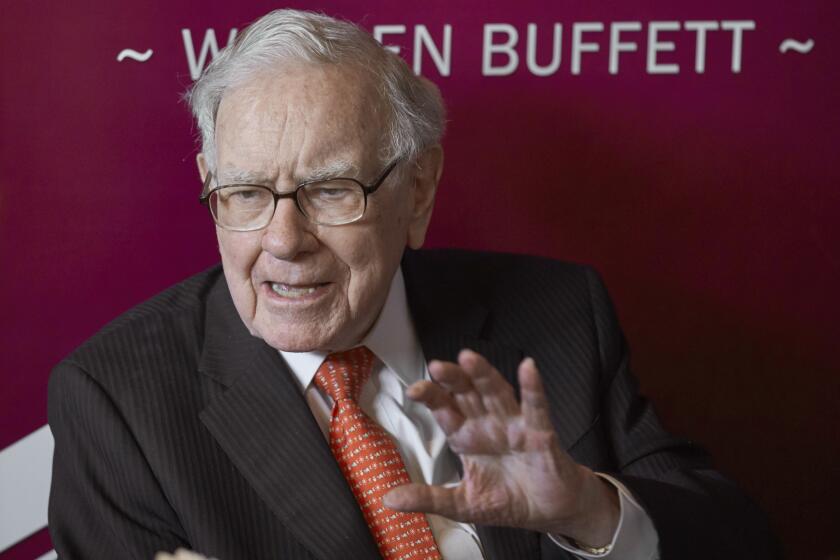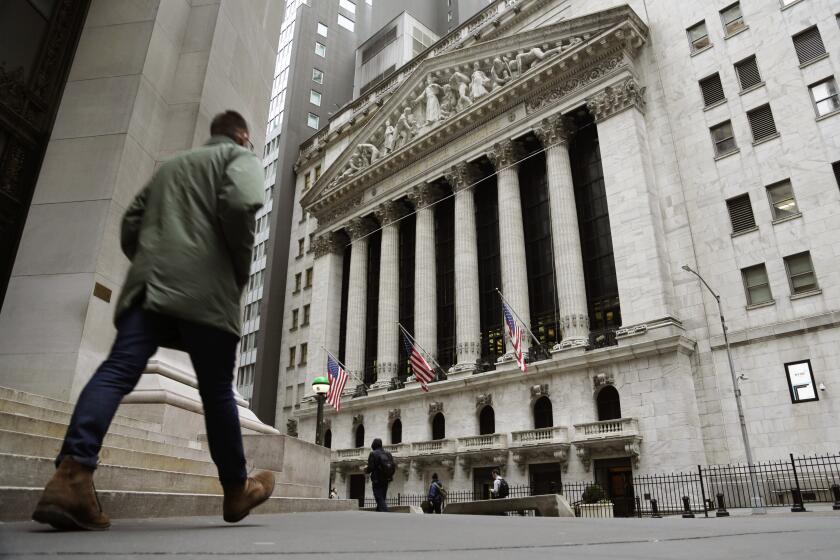Column: Why did Wells Fargo’s Stumpf lose his job, while JPMorgan’s Dimon kept his?
- Share via
Advocates of greater accountability for executives in the banking sector cheered this week when Wells Fargo Chairman and Chief Executive John Stumpf lost both his jobs.
Stumpf’s defenestration made him by far the highest-ranking banker to take the fall for his company’s misdeeds — in this case a scandal in which Wells Fargo bankers opened bogus accounts for customers and others without their knowledge, all to meet relentless quotas imposed by higher-ups.
Yet one group of observers hasn’t been cheering: Stumpf’s fellow bank CEOs. That may be partially because he was one of them, the very model of a silver-haired, confident man of affairs. But their reactions may be muted because his departure returns the spotlight to the burning question of why the heads of other scandal-plagued banks are still in place. We’re talking about one in particular: the chairman and CEO of JPMorgan Chase & Co., Jamie Dimon.
A complete tempest in a teapot.
— JPMorgan Chairman and CEO Jamie Dimon reacts to the ‘London Whale’ fiasco, which cost his bank more than $7 billion
Dimon, who has been ensconced as CEO since 2005 and chairman since 2006, has regained his stature as the banking industry’s smooth-talking front man after a couple of corporate missteps, which allowed Stumpf to emerge as the industry’s Mr. Clean.
As recently as Oct. 3, during a phone interview with CNBC (see clip below), Dimon could be heard advocating for tolerance in the judging of Stumpf, who had just executed two of the most maladroit appearances before congressional committees in memory.
“I think cooler heads should prevail sometimes,” Dimon said. “We should all be a little careful about the statements that are being made right now.” Prodded gently by CNBC anchor Tyler Mathisen to respond to Hilary Clinton’s critique of the “cowboy culture” on Wall Street (“How does that make you feel?” Mathisen asked), Dimon took the bit between his teeth.
“When people blanket a whole class of people by making statements, that’s just unfair to everybody,” he said. “They’re just never accurate. This business is full of high-quality, qualified, talented, ethical people. … And you all in the press don’t have to fuel it all the time by adding to it and oversimplifying it.”
Perhaps he’s right. So let’s weigh Dimon’s record by referring to the official disclosures made by his own bank.
The nadir of Dimon’s tenure came in 2012 and 2013, starting with the spectacular losses attributed to the company’s London trading office, including an indulgently supervised trader nicknamed the “London Whale.”
When the fiasco broke but before its magnitude was publicly known, Dimon dismissed it as “a complete tempest in a teapot.” As it transpired, the bank lost more than $7 billion in the affair, including a $1-billion regulatory penalty — a pretty big teapot. An internal investigation tried to sugar-coat Dimon’s responsibility, but was damning nonetheless — or would have been in a culture of genuine accountability.
“As Chief Executive Officer,” the report observed, “Mr. Dimon could appropriately rely upon senior managers who directly reported to him to escalate significant issues and concerns. However, he could have better tested his reliance on what he was told. This Report demonstrates that more should have been done regarding the risks, risk controls and personnel associated with CIO’s activities.” Dimon took a pay cut, leaving him with a measly $11.5 million for 2012.
By then, it was clear that Dimon’s institution was involved in lawbreaking or shady practices in numerous fields. As I observed in 2013, its annual report “listed legal exposure in no fewer than 19 categories,” including the sale of mortgage securities, alleged manipulation of international interest rates, involvement in the Bernie Madoff ponzi scheme, an allegedly fraudulent bond deal involving the city of Milan, and the manipulation of the California electricity market, which I documented here and here.
Federal energy regulators let the bank off with a $410-million penalty, which looked like a big number but really amounted to chump change for a bank that collected $97 billion in annual revenue. That was just one example of how JPMorgan skated on accusations of wrongdoing by deploying its wealth to settle accusations without admitting guilt.
What’s most striking in retrospect is that Dimon survived scandals and penalties that make Wells Fargo’s look like peanuts. John Stumpf’s downfall was triggered by a settlement with federal regulators and the Los Angeles city attorney’s office totaling $185 million. Dimon’s bank declared litigation expenses of $9 billion in the third quarter of 2013 alone, which wiped out its quarterly profits, and then some. That’s not even counting the London Whale loss.
So what made the difference? For one thing, Dimon handled his congressional hearings far more smoothly than Stumpf, who tried to dodge and weave in his appearances, but only came off as a weaseler.
Perhaps more important, JPMorgan’s misdeeds tended to involve complicated transactions that laypersons could not understand. The Whale trading was in complex derivatives that the bank itself couldn’t understand, much less members of Congress or the average TV viewer. The victims of most of these alleged frauds were other bankers and Wall Street firms, and too bad about them.
Wells Fargo’s scandal, by contrast, is painfully easy for the layperson to understand, and hits most people where they live. It’s about identity theft, and the victims are Wells Fargo’s own retail customers — you and your neighbors. As Helaine Olen observed at Slate, “most of us can’t explain what a bet on a credit-default swap is, but we know exactly what to call Wells’ actions.” Few men and women on the street own a derivative, but almost everyone has a bank account or credit card account. When those can’t be trusted, people get mad, and so do their members of Congress.
That’s why Stumpf had to go and the likelihood remains that more heads will roll at Wells Fargo; his designated successor as CEO, Tim Sloan, isn’t out of the woods himself.
And it’s why Dimon, a teensy bit poorer after being docked in pay for 2012, lived on to fight the good fight for his fellow bankers, wondering aloud on TV why anyone would think the banking industry wasn’t filled to the brim with men and women of unquestioned integrity.
Keep up to date with Michael Hiltzik. Follow @hiltzikm on Twitter, see his Facebook page, or email [email protected].
Return to Michael Hiltzik’s blog.
More to Read
Inside the business of entertainment
The Wide Shot brings you news, analysis and insights on everything from streaming wars to production — and what it all means for the future.
You may occasionally receive promotional content from the Los Angeles Times.











